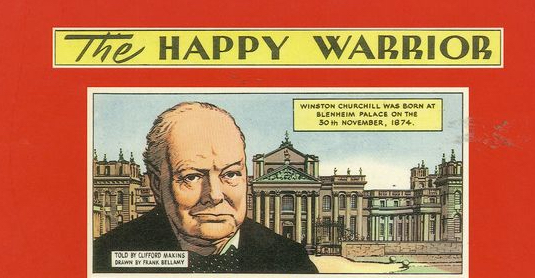
Best Churchill Books for Young Readers
Please send me some book recommendations on Churchill’s life for young readers. By young, I mean a boy of seven years old. My nephew asked me about the book I was reading (Churchill: The Unexpected Hero by Paul Addison), and after I told him a little about it, he wanted to know more. I’d appreciate any recommendations. —R.M., Mass. (Updated from 2009.)
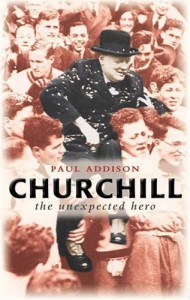 Paul Addison’s Churchill: The Unexpected Hero is probably the best “brief life” in print. If your nephew was into that at seven, he was far advanced. There are several other fairly short but excellent books of Addison’s quality, but they may be a shade advanced for readers so young. Among them, for the record:
Paul Addison’s Churchill: The Unexpected Hero is probably the best “brief life” in print. If your nephew was into that at seven, he was far advanced. There are several other fairly short but excellent books of Addison’s quality, but they may be a shade advanced for readers so young. Among them, for the record:
Martin Gilbert, Churchill: A Photographic Portrait
Douglas Russell, Winston Churchill: Soldier
Mary Soames, A Churchill Family Album—photo documentary
Number one for young readers
Fiona Reynoldson, Leading Lives: Winston Churchill. London: Heinemann Library “Leading Lives” series, 2001, 64 pp. hardbound, illustrated, later reprinted in paperback (currently more expensive on Amazon). Search also Bookfinder for clean used copies.
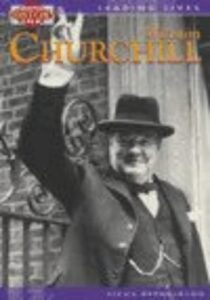 Targeted at the young (ages 8-15), now a quarter century old, this is still the best “juvenile” ever published anywhere, by anybody. The “Leading Lives” series mixes Stalin, Hitler, Mussolini and Arafat with Roosevelt, Kennedy and Gandhi. I know nothing about the other volumes, but Reynoldson’s Churchill is a masterpiece.
Targeted at the young (ages 8-15), now a quarter century old, this is still the best “juvenile” ever published anywhere, by anybody. The “Leading Lives” series mixes Stalin, Hitler, Mussolini and Arafat with Roosevelt, Kennedy and Gandhi. I know nothing about the other volumes, but Reynoldson’s Churchill is a masterpiece.
So much wisdom is attractively wedged into sixty-four pages! There’s a quality laminated cover; color throughout, including excellent photographs, cartoons, and posters. Sir Winston receives twenty brief chapters, including a summary, “Churchill’s Legacy.” There is an events timeline, a list of key people, good maps, a page showing how British government works, sources for further reading, a glossary and an index.
The glossary is one of this book’s fine features. Every time a word or phrase pops up that might be unfamiliar to young eyes—Nobel Prize, Boer War, Abdication, Home Secretary, VC, Bolshevik, DSO, Gold Standard, Home Rule, etc.—it is bold faced and referenced in a three-page appendix. This is not haphazard. There are over sixty entries, and every explanation is simple and accurate. It’s a wonder why more books for the young don’t offer this.
Sidebars that teach
Another special aspect is the set of sidebars that pace the story. These are carefully placed, written in precise English, and explain exactly what Churchill did and why. And Reynoldson is never wrong. Take his speech impediment, often misrepresented as a stutter. Reynoldson writes:
Churchill came home on leave in 1897 and went to see a doctor in London about his lisp. He pronounced ‘s’ as ‘sh.’ Nothing was found to be wrong, but the lisp never went away. Despite this, he made his first political speech during his leave and later became a great orator [glossary link] in the House of Commons.”
Perfect. Other sidebars offer rare insights to Churchill’s character. Take his letter to his wife in February 1945:
[M]y heart is saddened by the tales of the masses of German women and children flying along the roads…before the advancing armies…. The misery of the whole world appalls me, and I fear increasingly that new struggles may arise out of those we are successfully ending.
How well this dispels popular slander about how Churchill instituted and even enjoyed firebombing civilians.
The author delivers unadulterated, factual information. As with any good journalist, you have no idea how she feels personally about her subject. She deals in facts: entertainingly, even eloquently.
Writing a compact book, especially for the young, on a complicated subject is hard work. You must know what to highlight, what to jettison. To choose the right subjects, to represent them deftly, is a great achievement. Fiona Reynoldson’s young readers will develop their own perceptions of Churchill—thoroughly grounded in the education she provides. We should all buy five copies of this book and get them into the hands of schools, libraries and young people of promise.
Best for ages 12-18
John Severance, Winston Churchill: Soldier, Statesman, Artist. Boston: Houghton Mifflin Clarion Books, 1996, 144 pp. hardbound, illustrated, $19.95 used from Amazon. Search also Bookfinder for clean used copies.
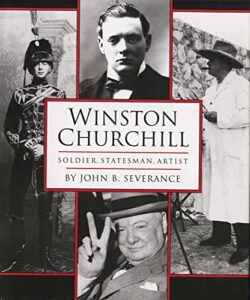 This one is even older, but bears mentioning. The first we heard of it was when Lady Soames remarked that someone had finally done her father justice in a book for young people. Soldier, Statesman, Artist was, she said, “intelligently written and beautifully printed.” Certainly the public must agree, for it was in print for more than a decade. Happily, copies are still available.
This one is even older, but bears mentioning. The first we heard of it was when Lady Soames remarked that someone had finally done her father justice in a book for young people. Soldier, Statesman, Artist was, she said, “intelligently written and beautifully printed.” Certainly the public must agree, for it was in print for more than a decade. Happily, copies are still available.
The target audience is older than Reynoldson’s. Like her book, there are no new revelations. Severance sets out to explain Churchill and his times to young people who have not heard much about them in school. Like Reynoldson, he acquaints non-British readers with how Parliament works. His tidy prose covers all the “great contemporaries”—Lloyd George, Stalin, Roosevelt, Gandhi, Hitler—and what they did.
Good writing iaccompanies elegant book design: fine type, artwork and photos that are not “old chestnuts. Admirably there is an index, a bibliography and an appendix sampling of “Winston’s Wit.”
There is a small rash of errors, not engendered by malice, ignorance, or conspiracy theories. The book is too short to give much attention to episodic excitements like the charge at Omdurman, the escape from the Boers, Armistice Day or 10 May 1940. Severance has a different tactic in mind.
Myth busting
He focuses on and demolishes numerous myths. For example, he notes that Churchill sent policemen, not troops, to pacify the strikers in Tonypandy. Facts are pounded in: Churchill inspired but did not invent the tank. The Dardanelles campaign was conceptually brilliant and ruined by incompetent execution. Churchill opposed the India Act, but sent Gandhi encouragement when it passed. WSC clung to office in the Fifties only because he thought he might be able to save the peace. Not the kind of thing young people tend to hear a lot.
On the wartime “spheres of influence” agreement with Stalin, over which Churchill’s detractors consistently fulminate, Severance has a point worth considering—and not just by young people: “Perhaps Churchill thought this was the only sort of plan Stalin would understand and accept.” Got it in one.
Some day we may have a Prime Minister or a President who as a youth was inspired by one of these books. Fiona Reynoldson and John Severance have done history as well as Churchill a great favor. Everyone who appreciates the great man is in their debt.
The Eagle’s cartoon biography
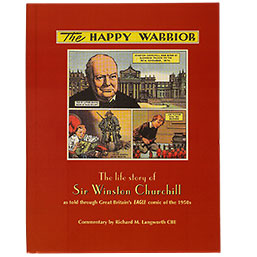
Levenger, the well-known purveyor of bookman’s accessories, was for a time in the publishing business. Their excellent editor, Mim Harrison, took an interest in Churchill, publishing The Making of the Finest Hour in 2006. This book, on how Churchill wrote his most famous speech, contained contributions by WSC’s late grandson Winston and me. Ms. Harrison then asked me to write a commentary for the Happy Warrior biography, which they were republishing.
David Freeman described this as a “graphic novel, in the argot of today’s youth.” Its origins were as a serialized Churchill biography in The Eagle, a comic magazine for boys. Published separately by Hulton Press in 1958, the story line was by Clifford Makins, with lifelike illustrations by Frank Bellamy.
The Levenger Happy Warrior was of much finer production quality. Despite its plebeian origins as a cartoon series, it is an accurate account of Churchill’s life up to his retirement as Prime Minister in 1955. Bellamy’s illustrations of people are remarkably true to life, and the dialogue (invented, most of it) is believable. Levenger’s production assured that the quality of reproduction was far superior to the original. The Happy Warrior is still available. It first sold for $39, but Amazon now sells new copies for $29.95.
Related reading
“A Sun That Never Sets: Churchill’s Autobiography My Early Life,” 2018.
“Myths and Heresies: Firebombing the Black Forest,” 2024.
“Paul Addison 1943-2020: What Matters is the Truth,” 2020.







One thought on “Best Churchill Books for Young Readers”
Thank you for the mention of my book, Winston Churchill Soldier. It will be republished next year by Pen & Sword Books in England. I hope a new generation of readers may enjoy it and even learn from it. As ever, Doug.
Comments are closed.